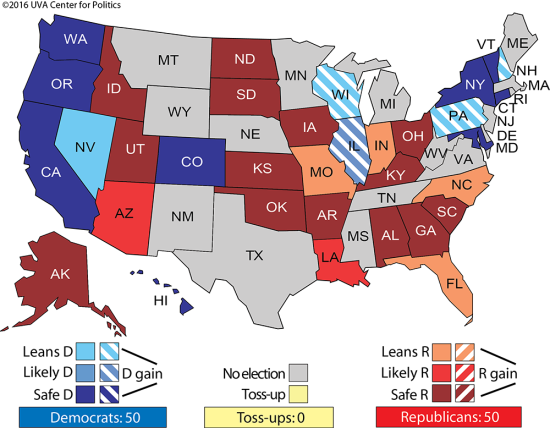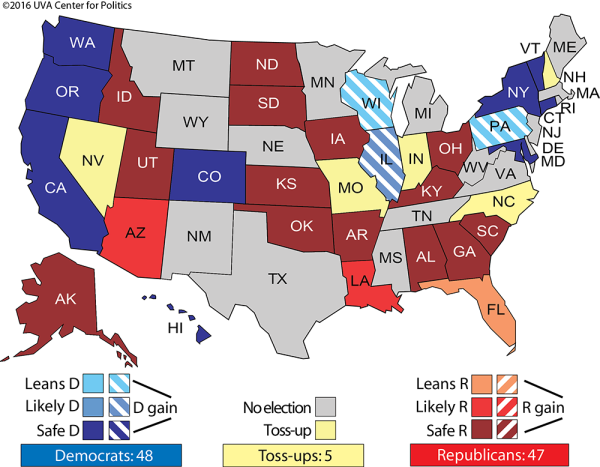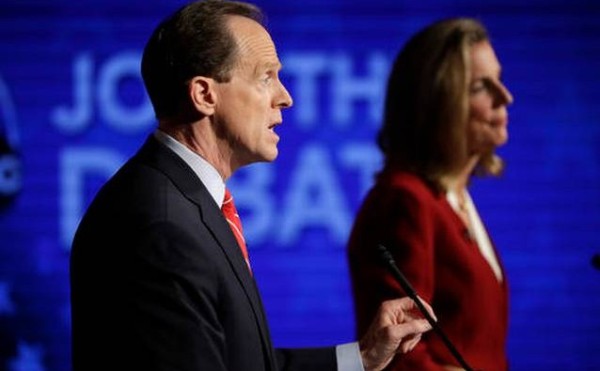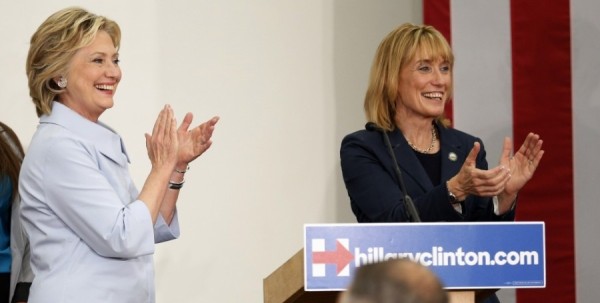PHOTO: New Hampshire Governor Maggie Hassan, shown with Hillary Clinton, is hoping to win the Senate seat for the Democrats
UPDATE, NOV 8: Entering Election Day, the contest for control of the Senate is a toss-up.
Democrats and Republicans are tied 47-47 in the races which are considered safe or uncontested.
The GOP now appear to have solid leads in North Carolina, with Republican incumbent Richard Burr likely to retain his seat, and in Indiana with Todd Young’s advantage over Democrat Evan Bayh. In Missouri, Roy Blunt still has a narrow lead over Democrat Jason Kander.
However, Democrat Katie McGinty is still a solid favorite to win Pennsylvania from Republican incumbent Pat Toomey, and Catherine Cortez Masto has increased her chances of holding the seat in Nevada vacated by Harry Reid, the retiring Democratic leader in the Senate.
That leaves New Hampshire as a possibly decisive race, with Democratic Governor Maggie Hassan slightly ahead of Republican incumbent Kelly Ayotte.
Democratic victories in Pennsylvania, Nevada, and New Hampshire would lead to a 50-50 Senate. The Vice President of the winning party in the Presidential election would then cast the deciding vote.

Map: University of Virginia’s Center for Politics
ORIGINAL ENTRY: The spectacle around the Trump v. Clinton race for the Presidency has overshadowed the equally significant battle for control of the US Senate.
While Republicans will maintain their majority in the House of Representatives — the GOP has a 60-seat advantage going into the vote — their advantage in the upper chamber is under threat.
The GOP currently has 54 seats. The Democrats have 44. Two Independents, and independents Angus King of Maine and Bernie Sanders of Vermont caucus with them.
However, the Republicans are far more vulnerable than their opposition this year. The GOP is defending 24 seats, and the Democrats only 10.
See also US Analysis: Your Essential Guide to the Presidential Election
If the Democrats can get a net gain of 5 seats, they will take control. They will also lead the chamber if they take four seats and Hillary Clinton wins the Presidency: in a 50-50 situation, the Vice President casts the deciding vote.
Can they do it? We think so: here’s our look at the key States that will decide the question.
Tied at the Starting Line
The Democrats have 36 members (counting King and Sanders) who do not face re-election. Of the 10 seats they are defending, they are safe in nine of them.
The Democrats are close to a lock in taking seats from the GOP in Illinois and Wisconsin. In Illinois, highly-regarded war veteran Tammy Duckworth is a 98% favorite to defeat the struggling incumbent Mark Kirk. In Wisconsin, Russ Feingold — who held the seat from 1993 to 2011 — is about a 90% favorite to retake the seat from Russ Feingold.
The GOP have 30 members who are not up for re-election. Of the 24 seats they are defending, they should be safe (at least 85% favorite) in 17 of them.
So that’s 47-47 going into the six closest races.

Map: University of Virginia Center for Politics
The Decisive Races
Nevada
This is the one seat that the Democrats are fighting to retain. Harry Reid, the Senate Majority Leader, is giving up his seat after 30 years.
The race has swung back-and-forth between Democrat Catherine Cortez Masto, Attorney General from 2007 to 2015, and Republican Joe Heck, a US Representative since 2011.
Heck appearing to be building a lead in October but then appeared to be hindered by the sexual abuse allegations against Donald Trump. The representative withdrew his support from Trump, and still will not say if he is voting for the Republican nominee.
North Carolina
Republican incumbent Richard Burr, who has held the seat since 2005 and is chair of the Senate Intelligence Committee, appeared to be on the path to re-election until mid-September. However, Democrat Deborah Ross, a former member of the State Assembly, closed the gap with the race becoming a toss-up last week.
Ross could also benefit from a rush of early voting, if the reported strong showing for Hillary Clinton translates into Democratic backing in the Senate race.
Burr has recovered in latest polls and should hold on, but the result is far from certain.
Missouri
Republican incumbent Roy Blunt, a 14-year Representative who moved up to the Senate in 2011, suddenly found himself in a race in mid-October. Democrat Jason Kander, Missouri’s Secretary of State, surged in the polls and even moved into the lead in some surveys.
Blunt has rallied in the latest polling but the race is a 50-50 toss-up.
New Hampshire
Republican incumbent Kelly Ayotte, seeking her second term, has trailed for much of the campaign to Democratic Governor Maggie Hassan.
Ayotte recovered in September but, still trailing, became the first Republican Senator to withdraw support from Donald Trump following the sexual abuse allegations.
The recovery has not lasted, however, and Hassan is still the favorite going into Tuesday’s vote.
Indiana
The seat is open, following the retirement of Republican Dan Coats. Democrat Evan Bayh, who held the seat from 1999 to 2011, is trying to return to Washington by defeating Republican Todd Young, who has been in the House of Representatives since 2011.
Bayh has led in every reliable poll since August, although the gap has been closing.
Pennsylvania
This is the best bet for the Democrats among the decisive states. Katie McGinty, known for her work in environmental protection, has been ahead of one-term Republican incumbent Pat Toomey throughout the autumn, and the lead has increased in the past week.
McGinty’s advantage of about 3% could disappear, but it looks like Republicans will have to have a surge in turnout to avoid losing the seat.

Toomey and McGinty in their final debate, October 24
The Prospects
The Democrats’ advantages in New Hampshire, Indiana, and Pennsylvania should take them to the 50 mark. That would be enough for control with a President Clinton.
However, given that Clinton’s success is no longer assured, Democrats will look to Nevada or Missouri to get the decisive 51st. North Carolina would be a bonus.
Of course, a slim majority is not sufficient to ensure victory in the immediate challenges for the Senate, such as the consideration of Merrick Garland as the next Supreme Court Justice. President Clinton would have to hold together the party’s members to avoid any defections, while President Trump takes the Executive-Congress relationship into unknown territory.
However, the return of a Democratic majority would be an important symbolic marker, following the often bitter contests between the Republican Senate leadership and the White House in recent years. And it would put pressure on a GOP whose fundamental divisions have been exposed by the Trump phenomenon.
Conversely, if the Republicans can hang on to the majority despite the turmoil caused by Trump and the split between the conservative and moderate wings of the GOP, then a bit of time and breathing space might have been earned to regroup.

